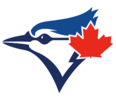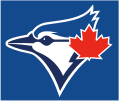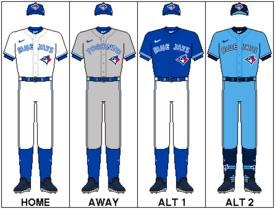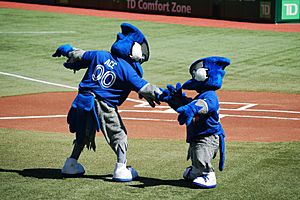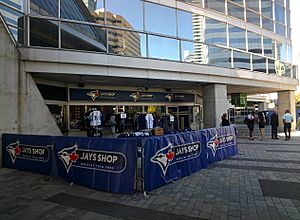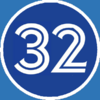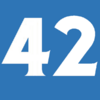Toronto Blue Jays facts for kids
Quick facts for kids Toronto Blue Jays |
|||||
|---|---|---|---|---|---|
|
|||||
|
|||||
| Major league affiliations | |||||
|
|||||
| Current uniform | |||||
| Retired numbers | |||||
| Colours | |||||
|
|||||
| Name | |||||
|
|||||
| Other nicknames | |||||
|
|||||
| Ballpark | |||||
|
|||||
| Major league titles | |||||
| World Series titles (2) |
|
||||
| AL Pennants (3) |
|
||||
| AL East Division titles (7) |
|
||||
| Wild card berths (4) |
|
||||
| Front office | |||||
| Principal owner(s) | Rogers Communications | ||||
| President | Mark Shapiro | ||||
| General manager | Ross Atkins | ||||
| Manager | John Schneider | ||||
The Toronto Blue Jays are a professional baseball team from Toronto, Canada. They play in Major League Baseball (MLB) as part of the American League's East Division. Since 1989, their main home field has been Rogers Centre in downtown Toronto.
The team's name, "Blue Jays," comes from the colorful blue jay bird. Blue is also a traditional color for many sports teams in Toronto. In 1976, over 4,000 people suggested names, and 154 chose "Blue Jays." The team was first owned by the Labatt Brewing Company, known for its "Labatt Blue" beer. People often call the team the "Jays." Their official colors are royal blue, white, navy blue, and red.
The Blue Jays started as a new team in Toronto in 1977. They first played at Exhibition Stadium before moving to SkyDome (now Rogers Centre) in 1989. They are the only MLB team located outside the United States. Since 2000, Rogers Communications has owned the Blue Jays. Rogers Communications also bought SkyDome in 2004 and renamed it Rogers Centre.
Because of travel rules during the COVID-19 pandemic, the Blue Jays played some home games away from Toronto in 2020 and 2021. They played at TD Ballpark in Florida and Sahlen Field in New York before returning to Rogers Centre in July 2021.
In their early years (late 1970s and early 1980s), the Blue Jays faced challenges, like many new teams. They had their first winning season in 1983 and became division champions in 1985. From 1985 to 1993, the Blue Jays were a very strong team in the American League East. They won five division championships in nine seasons, including three in a row from 1991 to 1993. During this exciting time, they also won the World Series two years in a row, in 1992 and 1993! Star players like Roberto Alomar, Joe Carter, John Olerud, and Devon White led the team. The Blue Jays were the first team outside the U.S. to win a World Series.
After 1993, the Blue Jays did not make the playoffs for 21 seasons. But they returned to the playoffs and won their division in 2015. They made the playoffs again in 2016 as a wild card team. In both years, they beat the Texas Rangers in the first round but lost in the championship series. More recently, they qualified for the playoffs as a wild card team in 2020, 2022, and 2023. In 2025, the Blue Jays won their seventh division title and their third American League pennant. They reached the World Series but lost to the Los Angeles Dodgers in seven games.
From 1977 to 2025, the Blue Jays' overall record was 3,855–3,856–3 (.500).
The Blue Jays' Story
The Toronto Blue Jays team started in 1976. They were one of two new teams joining the American League for the 1977 season. Toronto had wanted a major league baseball team for a long time. There was even a local team called the Toronto Maple Leafs baseball team that played from 1896 to 1967.
In 1976, the San Francisco Giants almost moved to Toronto. A group of Canadian companies wanted to buy them and rename them the Toronto Giants. But a court decision stopped the move. Still, Toronto's dream of an MLB team came true with the 1976 expansion.
The new Toronto team was bought for $7 million. A contest helped choose the name "Toronto Blue Jays." The name honored Toronto's tradition of using blue in team colors. It was also influenced by the main owner, Labatt Breweries, known for its "Labatt Blue" beer. The team's first employees included Paul Beeston, Peter Bavasi, and Pat Gillick.
The Blue Jays played their first game on April 7, 1977. They won against the Chicago White Sox during a snowstorm! Through the late 1970s and early 1980s, the team slowly got better. They had their first winning season in 1983. In 1985, under manager Bobby Cox, they won their first American League East title.
The late 1980s and early 1990s were a golden age for the Blue Jays. Under manager Cito Gaston, they won many division titles. They also won back-to-back World Series championships in 1992 and 1993. This made them the first team outside the U.S. to achieve this! Key players from this time included Roberto Alomar, Joe Carter, and Dave Stieb.
After some challenging times in the mid-1990s, new stars like Roy Halladay and Carlos Delgado emerged. In the late 1990s, the team also saw Roger Clemens join. In the early 2000s, general manager J. P. Ricciardi helped rebuild the team. By the mid-2000s, the Blue Jays were competitive again. The 2010s brought more excitement with playoff appearances in 2015 and 2016. Stars like José Bautista and Josh Donaldson led the way. The Blue Jays continued to build for success with young talents like Vladimir Guerrero Jr. and Bo Bichette. Cavan Biggio was also a key player before he was traded in 2024.
2024 Season Highlights
During the off-season, the Blue Jays re-signed Kevin Kiermaier. They also added new players like Isiah Kiner-Falefa, Justin Turner, and pitcher Yariel Rodríguez. The team traded Santiago Espinal for a promising young pitcher.
In the regular season, the Blue Jays traded Cavan Biggio for another prospect. Before the 2024 trade deadline, the team made several trades. They sent away players like Yimi García, Nate Pearson, Danny Jansen, Justin Turner, Yusei Kikuchi, Trevor Richards, Isiah Kiner-Falefa, and Kevin Kiermaier.
2025 Season Highlights
The Toronto Blue Jays signed Anthony Santander and Max Scherzer during the off-season. They also extended Vladimir Guerrero Jr.'s contract for $500 million over 14 seasons. This made him one of the highest-paid athletes in the world.
Before the 2025 trade deadline, the Blue Jays traded for Seranthony Domínguez, Shane Bieber, Louis Varland, and Ty France.
The Blue Jays reached the World Series but lost to the Los Angeles Dodgers in seven games.
Team Popularity
The Blue Jays have always been popular with fans. In their first year, 1977, they set an MLB record for a new team. Over 1.7 million fans attended their games that season.
In 1990, the team set another attendance record with over 3.8 million fans. In 1991, the Blue Jays became the first MLB team to attract over four million fans. They did it again in 1992 and 1993. Their 1993 attendance of over 4 million fans was an American League record for 12 years.
Many Blue Jays players became very popular. Dave Stieb was selected to the All-Star team seven times, a team record. Roy Halladay and José Bautista were chosen six times each. Roberto Alomar and Joe Carter were selected five times each. In 2011, José Bautista received a record 7,454,753 All-Star votes. In 2015, Josh Donaldson broke that record with 14,090,188 votes!
The Blue Jays are popular across Canada. They are the only MLB team in the country. They have played exhibition games in places like Vancouver, Buffalo, and Montreal. This allows fans from different parts of Canada to see them play.
Team Culture
Music and Chants
During the seventh-inning stretch at home games, fans sing and clap to the song "OK Blue Jays." This happens before they sing "Take Me Out to the Ball Game." The song was first released in 1983. A shorter version has been played since 2003.
Fans also hear the "Let's Go Blue Jays" chant played four times, followed by the "Charge" fanfare three times.
Team Mascots
From 1979 to 1999, BJ Birdy was the Blue Jays' only mascot. In 2000, two new mascots, Ace and Diamond, took over. After the 2003 season, Diamond was removed, leaving Ace as the sole mascot. Since the 2010s, Ace has sometimes been joined by his younger brother, Junior, especially during special "Jr. Jay" promotions.
Sunday Salute
Since 2012, at every Sunday home game, the Blue Jays honor a member of the Canadian Armed Forces. In the third inning, the team gives the honored member a special jersey.
National Anthems
Since 2005, "The Star-Spangled Banner" (the U.S. anthem) is sung before "O Canada" (the Canadian anthem) at every home game. This is because all Blue Jays opponents are from the United States. For some games, like Canada Day, "O Canada" is sung in both English and French. This shows Canada's diverse culture. Sometimes, it has even been sung in Indigenous languages like Cree, Anishinaabemowin, and Blackfoot. A giant Canadian flag is often displayed during "O Canada" for important games.
Canada Day Celebrations
The Blue Jays usually host an afternoon home game on Canada Day (July 1st). For this game, the team wears red jerseys instead of their usual blue ones. Before the game, a giant Canadian flag is presented while "O Canada" is sung in English and French.
Fan Appreciation Weekend
Fan Appreciation Weekend usually happens on the last weekend of September. It marks the team's final home games of the season.
Jays Shop
The Blue Jays have stores called Jays Shop that sell team merchandise. There are two locations at Rogers Centre. Until January 2023, there was also a store in the Toronto Eaton Centre shopping mall.
Team Uniforms
The Blue Jays' uniforms have changed several times over the years. Each era brought a new look to the team.
Early Years: Pullovers and Powder Blue (1977–1988)
In their first decade, the Blue Jays wore pullover uniforms. The home uniforms were white with the team name in blue and white letters. The road uniforms were light blue, also known as powder blue.
Championship Era: Buttoned Blues (1989–1996)
When the team moved to Rogers Centre in 1989, they switched to buttoned uniforms. The road uniforms became grey. The team also started wearing all-blue caps for all games by 1993. This change was partly due to a superstition after a losing streak!
Red, Teal, and Blue Look (1997–2003)
Before the 1997 season, the Blue Jays updated their logo. It featured a new bird design with a red maple leaf. The color red became more common on their uniforms. They also introduced a "Muscle Jay" logo, showing a blue jay flexing its arm.
Black and Graphite Era (2004–2011)
In 2004, the Blue Jays changed their colors to black, silver, and graphite. The home and black alternate jerseys simply said "Jays" on the front. The road uniforms featured the city name. Later, a red maple leaf was added to the right sleeve.
Return to Traditional Look (2012–Present)
Before the 2012 season, the Blue Jays returned to a look similar to their successful 1989–1996 uniforms. They brought back a modernized version of their original logo. In 2015, they also started wearing a modernized version of their white-paneled blue caps, which were popular in their early years. These caps made a special return for some games in 2025.
In 2020, the team brought back a modernized version of their powder blue uniforms. These uniforms feature navy, white, and navy letters and numbers.
Canada Day Uniforms
Since 1996, the Blue Jays have worn special red or red-accented uniforms on Canada Day (July 1st). These uniforms often include the flag of Canada or a red maple leaf.
City Connect Uniform
In 2024, the Blue Jays introduced a special "City Connect" uniform. It was inspired by Toronto's nightlife and is nicknamed "Night Mode." The dark blue jersey shows an illustration of the Toronto skyline in royal blue, with "Toronto" written in red. The cap is also dark blue with a red maple leaf.
Team Rivalries
Detroit Tigers
The Detroit Tigers are a traditional rival for the Blue Jays. This rivalry goes back to the 1980s when both teams were strong in the American League East. Detroit is about a four-hour drive from Toronto.
Seattle Mariners
Even though the Seattle Mariners are not in the same division, many Blue Jays fans from Western Canada travel to Seattle to see games. Seattle is closer to cities like Vancouver than Toronto is. In 2025, the Blue Jays and Mariners played an exciting American League Championship Series, with the Blue Jays winning in seven games.
Montreal Expos
The Montreal Expos were the Blue Jays' National League rival. They were the other Canadian MLB team before they moved to Washington, D.C. The teams used to play an annual exhibition game called the Pearson Cup. They started playing each other in regular season games in 1997.
Broadcasting Games
Radio Broadcasts
The Blue Jays' former radio announcer, Tom Cheek, called every game from 1977 until 2004. That was an amazing streak of 4,306 regular-season games! The team honored him by placing his initials and the number 4,306 in their "Level of Excellence" at Rogers Centre.
Blue Jays radio broadcasts come from Sportsnet 590 CJCL in Toronto. This station, like the Blue Jays, is owned by Rogers Communications. After Tom Cheek, Jerry Howarth became the main announcer. Later, Ben Wagner took over this role. During the 2021 pandemic, radio broadcasts were often the same as the TV broadcasts to reduce travel.
The Blue Jays have the largest home market in baseball, covering all of Canada.
Television Broadcasts
All Blue Jays games are shown nationally on Sportsnet, which is also owned by Rogers Communications. Currently, Dan Shulman is the main play-by-play announcer, with Buck Martinez as the primary color commentator. Sometimes, Matt Devlin and Joe Siddall also call games.
Sportsnet has been the team's main TV channel since the late 1990s. They became the exclusive broadcaster in 2010. Sportsnet One also shows games if there are scheduling conflicts.
Some Blue Jays games have been shown with special features. AMI-tv has simulcast games with described video for people who are blind or have low vision. Omni Television has aired games with commentary in Mandarin and Tagalog. TVA Sports broadcasts games in French.
Before 2022, Sportsnet could not use its own production for Blue Jays playoff games. They had to show the U.S. broadcast. But starting in 2022, MLB allowed Sportsnet to produce its own Blue Jays postseason games.
Team Roster
|
Toronto Blue Jays 2023 spring training roster
|
||||||
|---|---|---|---|---|---|---|
| 40-man roster | Non-roster invitees | Coaches/Other | ||||
|
Pitchers
|
Catchers
Infielders
Outfielders
|
|
Manager
Coaches
39 active, 0 inactive, 0 non-roster invitees
|
|||
Minor League Teams
The Toronto Blue Jays have several minor league teams where younger players develop their skills. These teams are called "affiliates."
| Class | Team | League | Location | Ballpark | Affiliated |
|---|---|---|---|---|---|
| Triple-A | Buffalo Bisons | International League | Buffalo, New York | Sahlen Field | 2013 |
| Double-A | New Hampshire Fisher Cats | Eastern League | Manchester, New Hampshire | Delta Dental Stadium | 2003 |
| High-A | Vancouver Canadians | Northwest League | Vancouver, British Columbia | Nat Bailey Stadium | 2011 |
| Single-A | Dunedin Blue Jays | Florida State League | Dunedin, Florida | TD Ballpark | 1987 |
| Rookie | FCL Blue Jays | Florida Complex League | Englebert Complex | 2007 | |
| DSL Blue Jays Red | Dominican Summer League | Boca Chica, Santo Domingo | Baseball City Complex | 2025 | |
| DSL Blue Jays Blue |
Season Records
Awards and Achievements
Award Winners and League Leaders
Team Records
| Statistic | Single season record | Career record | |||
|---|---|---|---|---|---|
| Player | Record | Season | Player | Record | |
| Games played: | Tony Fernández | 163 | 1986 | Tony Fernández | 1,450 |
| Plate appearances: | Vernon Wells | 735 | 2003 | Carlos Delgado | 6,018 |
| At bats: | Tony Fernández | 687 | 1986 | Vernon Wells | 5,470 |
| Batting average: | John Olerud | .363 | 1993 | Roberto Alomar | .307 |
| On-base percentage: | John Olerud | .473 | 1993 | John Olerud | .395 |
| Slugging percentage: | Carlos Delgado | .664 | 2000 | Carlos Delgado | .556 |
| On-base plus slugging: | Carlos Delgado | 1.134 | 2000 | Carlos Delgado | .949 |
| Runs scored: | Shawn Green | 134 | 1999 | Carlos Delgado | 889 |
| Hits: | Vernon Wells | 215 | 2003 | Tony Fernández | 1,583 |
| Total bases: | Carlos Delgado | 378 | 2000 | Carlos Delgado | 2,786 |
| Doubles: | Carlos Delgado | 57 | 2000 | Carlos Delgado | 343 |
| Triples: | Tony Fernández | 17 | 1990 | Tony Fernández | 72 |
| Home runs: | José Bautista | 54 | 2010 | Carlos Delgado | 336 |
| RBI | Carlos Delgado | 145 | 2003 | Carlos Delgado | 1,058 |
| Walks: | José Bautista | 132 | 2011 | Carlos Delgado | 827 |
| Stolen bases: | Dave Collins | 60 | 1984 | Lloyd Moseby | 255 |
| Games played (pitcher): | Mark Eichhorn | 89 | 1987 | Jason Frasor | 505 |
| Games started: | Jim Clancy | 40 | 1982 | Dave Stieb | 408 |
| Wins: | Roy Halladay | 22 | 2003 | Dave Stieb | 175 |
| Losses: | Jerry Garvin Phil Huffman |
18 | 1977 1979 |
Jim Clancy | 140 |
| Winning percentage: | Dennis Lamp | 1.000 | 1985 | Roger Clemens | .759 |
| Innings pitched: | Dave Stieb | 288.1 | 1982 | Dave Stieb | 2,873 |
| ERA: | Mark Eichhorn | 1.72 | 1986 | Tom Henke | 2.48 |
| Earned runs: | Erik Hanson | 129 | 1996 | Dave Stieb | 1,091 |
| Strikeouts: | Roger Clemens | 292 | 1997 | Dave Stieb | 1,658 |
| Complete Games: | Dave Stieb | 19 | 1982 | Dave Stieb | 102 |
| Shutouts: | Dave Stieb | 5 | 1982 | Dave Stieb | 30 |
| Saves: | Duane Ward | 45 | 1993 | Tom Henke | 217 |
No-Hitters
Only one Blue Jays pitcher has thrown a no-hitter in the team's history. Dave Stieb achieved this on September 2, 1990, against the Cleveland Indians. He had come very close to a no-hitter three other times, losing them with two outs in the ninth inning!
No perfect games have been thrown in Blue Jays history. A perfect game is when no opposing player reaches base at all.
| # | Date | Pitcher | Final score | Base- runners |
Opponent | Catcher | Plate umpire | Manager | Notes | Ref |
|---|---|---|---|---|---|---|---|---|---|---|
| 1 | September 2, 1990 | Dave Stieb | 3–0 | 4 | Cleveland Indians | Pat Borders | Drew Coble | Cito Gaston |
|
Triple Crown Winners
Roger Clemens won the pitching Triple Crown in both 1997 and 1998 while playing for the Blue Jays. To win a pitching Triple Crown, a pitcher must lead their league in wins, strikeouts, and earned run average (ERA).
Baseball Hall of Famers
Eleven former Blue Jays players, one former manager, and one former general manager have been chosen for the Baseball Hall of Fame. Roberto Alomar, a second baseman, was the first player to be inducted mainly for his time with the Blue Jays in 2011.
| Toronto Blue Jays Hall of Famers | |||||||||
|---|---|---|---|---|---|---|---|---|---|
| Affiliation according to the National Baseball Hall of Fame and Museum | |||||||||
|
Bobby Doerr, a Hall of Fame second baseman for the Boston Red Sox, was a hitting coach for the Blue Jays from 1977 to 1981. He was the first person connected to the team to be elected to the Hall of Fame.
Early Wynn, a Hall of Fame pitcher, was a radio broadcaster for the Blue Jays from 1977 to 1981.
Ford C. Frick Award Recipients
This award honors excellence in baseball broadcasting.
| Toronto Blue Jays Ford C. Frick Award recipients | |||||||||
|---|---|---|---|---|---|---|---|---|---|
| Affiliation according to the National Baseball Hall of Fame and Museum | |||||||||
|
BBWAA Career Excellence Award Recipients
This award recognizes excellence in baseball writing.
- Bob Elliott
Names in bold received the award mainly for their work covering the Blue Jays.
Canadian Baseball Hall of Fame
Many people connected to the Blue Jays have also been inducted into the Canadian Baseball Hall of Fame.
| Blue Jays in the Canadian Baseball Hall of Fame | ||||
|---|---|---|---|---|
| No. | Inductee | Position | Tenure | Notes |
| 12 | Roberto Alomar | 2B | 1991–1995 | |
| — | Gord Ash | GM | 1995–2001 | Born in Toronto, attended York University |
| — | Paul Beeston | Executive | 1976–1997 2008–2015 |
Born in Welland, Ontario, attended University of Western Ontario |
| 11 | George Bell | LF | 1981, 1983–1990 | |
| 29, 43 | Joe Carter | OF/1B | 1991–1997 | |
| — | Tom Cheek | Broadcaster | 1977–2004 | |
| 6, 21, 25 | Carlos Delgado | 1B | 1993–2004 | |
| — | Jacques Doucet | Broadcaster | 2011–present | Born in Montreal, elected mainly for his broadcasting career with Montreal Expos |
| 20, 22, 40 | Rob Ducey | OF | 1987–1992, 2000 | Born in Toronto, raised in Cambridge |
| 1 | Tony Fernández | SS | 1983–1990, 1993 1998–1999, 2001 |
|
| 35 | Jeff Francis | P | 2015 | Born in Vancouver, British Columbia, attended University of British Columbia |
| 43 | Cito Gaston | Manager | 1989–1997 2008–2010 |
|
| — | Pat Gillick | GM | 1978–1994 | |
| 32, 52 | Roy Halladay | P | 1998–2009 | |
| — | Peter Hardy | Executive | 1976–1993 | Born in Toronto, Ontario |
| 50 | Tom Henke | P | 1985–1992 | |
| 41 | Pat Hentgen | P | 1991–1999, 2004 | |
| 47 | Corey Koskie | 3B | 2005 | Born in Anola, Manitoba, attended University of Manitoba |
| — | Tony Kubek | Broadcaster | 1977–1989 | |
| 3 | Bobby Mattick | Manager | 1980–1981 | |
| 39 | Dave McKay | 2B/3B | 1977–1979 | Born in Vancouver, British Columbia |
| 15 | Lloyd Moseby | CF | 1980–1989 | |
| 9 | John Olerud | 1B | 1989–1996 | |
| 48 | Paul Quantrill | P | 1996–2001 | Born in London, Ontario |
| — | Jim Ridley | Scout | 1976–2002 | Born in Toronto |
| — | Gladwyn Scott | Scout | 1987–1993 | Born in Hamiota, Manitoba |
| 24 | Matt Stairs | OF/DH/1B | 2007–2008 | Born in Saint John, New Brunswick, grew up in Fredericton, New Brunswick |
| — | Howard Starkman | Executive | 1976–2014 | Born in Toronto |
| 37 | Dave Stieb | P | 1979–1992, 1998 | |
| 31 | Duane Ward | P | 1986–1995 | |
| 12 | Ernie Whitt | C | 1977–1978, 1980–1989 | |
Retired Numbers
|
On March 29, 2018, the Blue Jays retired number 32 in honor of Roy Halladay. He was a beloved pitcher who passed away in an airplane crash in 2017. This was the second number retired by the Blue Jays.
The first number retired by the Blue Jays was 12, for Roberto Alomar. This happened on July 31, 2011. However, number 12 was later unretired due to some serious concerns that arose. Jordan Hicks became the first Blue Jay to wear this number again in 2023.
Number 42, belonging to Jackie Robinson, is retired across all of Major League Baseball to honor his historic role in breaking the color barrier in baseball.
Level of Excellence
In 1996, the Blue Jays created a "Level of Excellence" at Rogers Centre. This honors people who made amazing contributions to the team.
- Tony Fernández (Shortstop, Third Baseman: 1983–1990, 1993, 1998–1999, 2001)
- George Bell (Left Fielder: 1981–1990)
- Carlos Delgado (First Baseman: 1993–2004)
- Joe Carter (Right Fielder, First Baseman: 1991–1997)
- Dave Stieb (Pitcher: 1979–1992, 1998)
- Cito Gaston (Manager: 1989–1997, 2008–2010)
- Tom Cheek (Broadcaster: 1977–2005)
- Paul Beeston (VP: 1976–1989; President: 1989–1997, 2008–2015)
- Roy Halladay (Pitcher: 1998–2009)
- Pat Gillick (General Manager: 1978–1994)
- José Bautista (Right Fielder, Third Baseman: 2008–2017)
The Level of Excellence originally showed players' uniform numbers. However, after a redesign in 2013, only the retired numbers for Roberto Alomar (#12) and Roy Halladay (#32), and Tom Cheek's 4306 game streak, were displayed. On April 30, 2021, the Blue Jays announced they would remove Alomar from the Level of Excellence after some serious concerns arose.
Charity and Community Work
The Jays Care Foundation is the charitable part of the Toronto Blue Jays team. They organize events to help local groups and people in the community. They also teach baseball skills and life lessons to young people across Canada.
See also
 In Spanish: Toronto Blue Jays para niños
In Spanish: Toronto Blue Jays para niños


